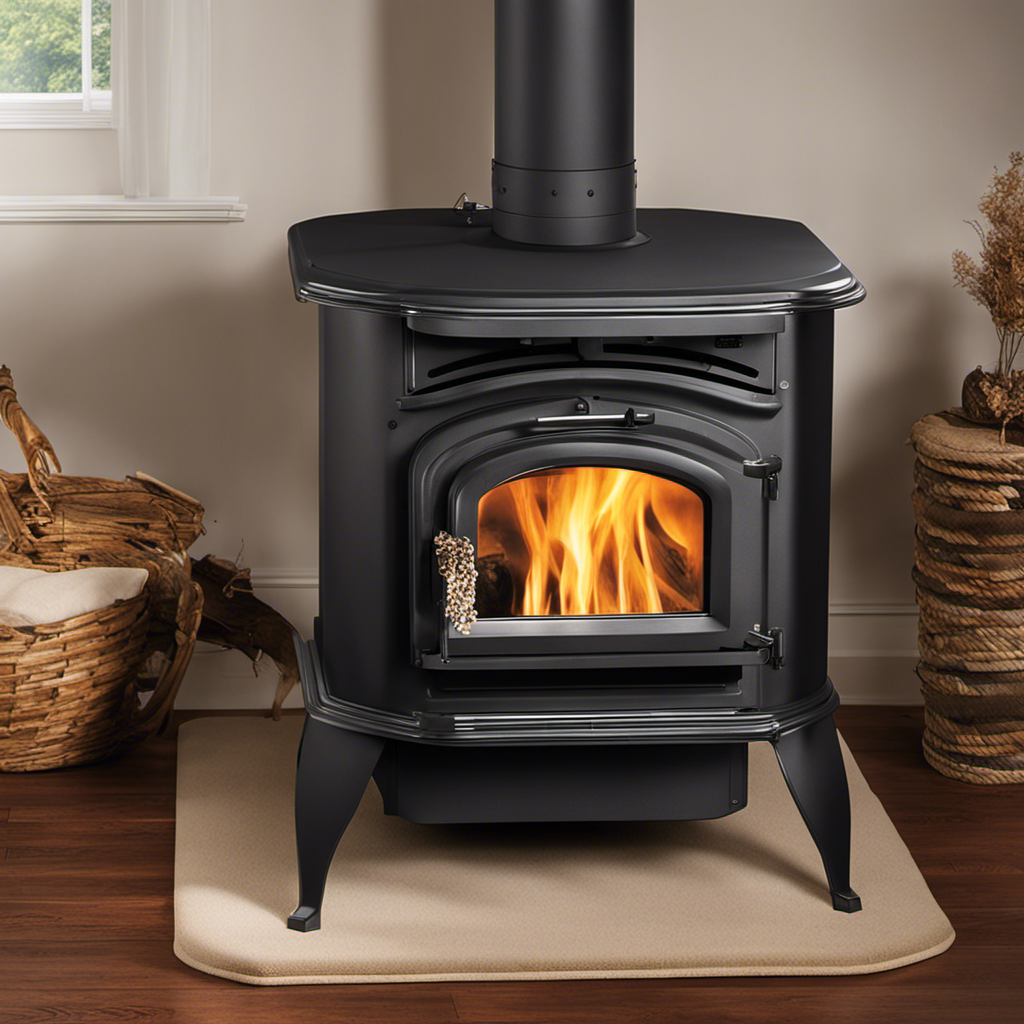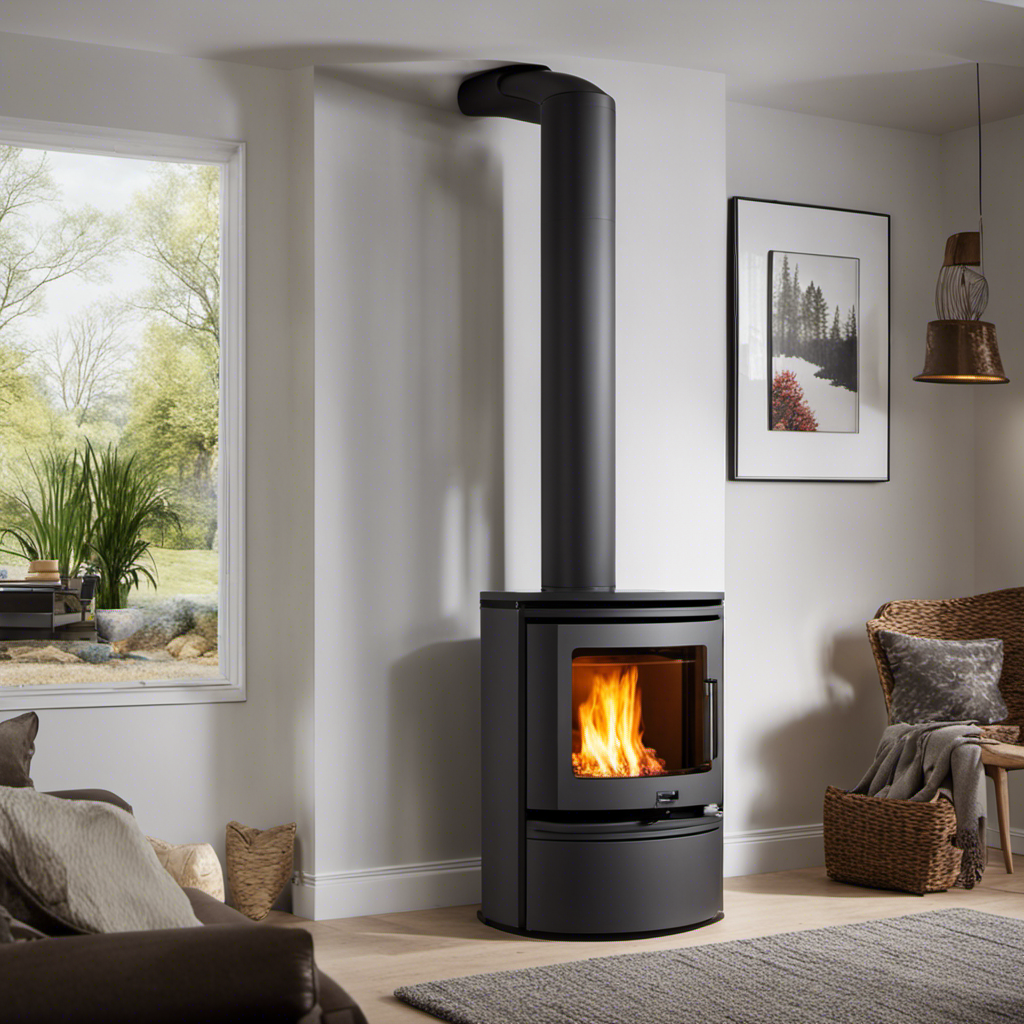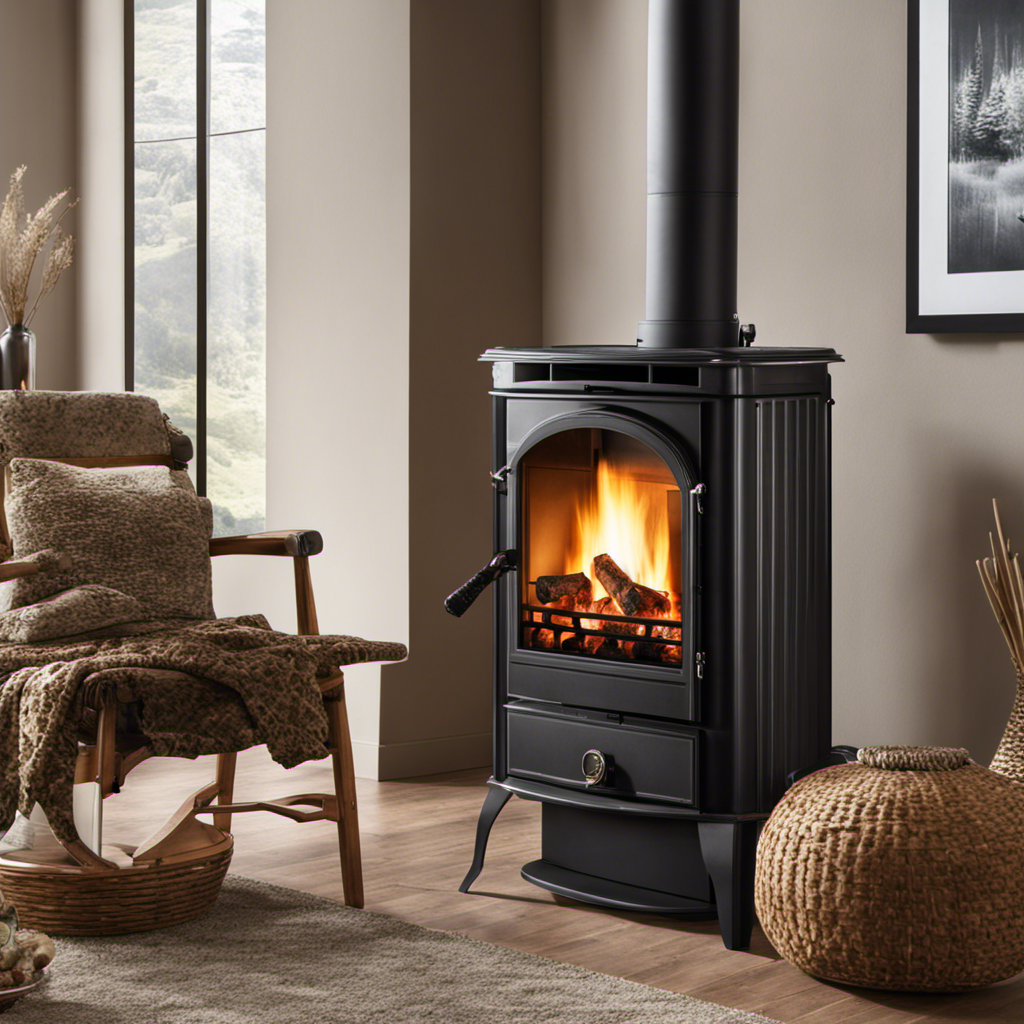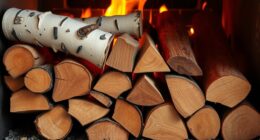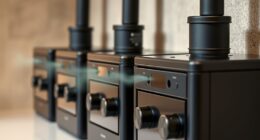Okay, here’s the deal: the exhaust fan on my St. Croix wood pellet stove won’t stop running, and I can’t seem to find a solution. No matter what I try, the fan seems determined to keep going. It’s almost like it has a mind of its own!
But fear not, fellow stove owners, because in this article we’re going to dive deep into the possible reasons behind this never-ending motor madness. From malfunctioning parts to dirty motors and everything in between, we’ll uncover the truth and find a solution to put an end to this exhaust motor marathon once and for all.
Key Takeaways
- Possible reasons for the continuous running of the exhaust motor on a St. Croix Wood Pellet Stove include malfunctioning of the motor, blocked exhaust vent or flue pipe, faulty thermostat or temperature sensor, and incorrect settings on the control panel.
- To fix the malfunctioning of the exhaust motor, one should inspect and clean the exhaust fan blades, lubricate motor bearings, and resolve any loose or damaged parts in the exhaust system.
- If the exhaust motor is continuously running due to a blocked exhaust vent or flue pipe, it is important to clear any blockages and ensure proper airflow. Additionally, one should check for damage or leaks in the vent system.
- In case of a faulty thermostat or temperature sensor, it is necessary to replace the damaged component. Consulting the user manual or a professional technician can provide guidance, and motor replacement may be required.
- Incorrect settings on the control panel can also cause the exhaust motor to continuously run. It is important to check the motor control settings, ensure they are set according to desired parameters, and verify that timers and schedules are correctly programmed.
Possible Malfunctioning of the Exhaust Motor
If your exhaust motor keeps running, it could be a sign of a malfunction. One common issue is excessive exhaust motor noise, which can indicate problems with the motor itself or its components. To troubleshoot this problem, there are a few tips you can follow.
First, check for any loose or damaged parts in the exhaust system that may be causing the noise. Tighten or replace them as necessary.
Next, ensure that the exhaust fan blades are clean and free from debris, as this can also contribute to excess noise.
Additionally, inspect the motor bearings for wear and tear and lubricate them if needed. By addressing these potential issues, you may be able to resolve the malfunctioning of your exhaust motor.
Now let’s move on to another potential cause of your stove’s continuous operation: a blocked exhaust vent or flue pipe…
Blocked Exhaust Vent or Flue Pipe
The most likely reason for the continuous running of your exhaust motor may be a blocked vent or flue pipe. When the vent or flue pipe becomes obstructed, it prevents proper airflow and causes the motor to work harder in order to expel the combustion gases. This can lead to overheating and potential damage to the motor.
To troubleshoot this issue, start by inspecting the vent and flue pipe for any debris, such as bird nests or excessive soot buildup. Clear any blockages and ensure that there is sufficient airflow. Additionally, check for any signs of damage or leaks in the vent system that may be causing improper exhaust flow. By addressing a blocked vent, you can eliminate one possible cause of your exhaust motor continuously running.
A possible alternative explanation for your exhaust motor continuously running could be a faulty thermostat or temperature sensor.
Faulty Thermostat or Temperature Sensor
A possible explanation for the continuous running of your exhaust motor could be a faulty thermostat or temperature sensor. If either of these components is not functioning properly, it may cause the motor to run continuously as it fails to receive the correct temperature readings.
To troubleshoot this issue, you can start by checking the thermostat and temperature sensor for any visible damage or loose connections. If everything looks fine, you may need to consider replacing the faulty component with a new one. Motor replacement is often necessary in such cases. However, before moving forward with any replacements, make sure to consult your stove’s user manual or contact a professional technician for proper guidance.
Now let’s explore another potential cause for your exhaust motor’s continuous running: incorrect settings on the control panel…
Incorrect Settings on the Control Panel
One possible reason for the continuous running of your exhaust motor could be incorrect settings on the control panel. To troubleshoot this issue, start by checking the motor control settings on your stove’s control panel. Ensure that the motor is set to operate according to the desired parameters. Verify that any timers or schedules are correctly programmed and not causing the exhaust motor to run continuously. It is also important to check if there are any error codes displayed on the control panel indicating a malfunctioning sensor or component related to motor control. If necessary, consult the user manual or contact customer support for further assistance in adjusting the control panel settings correctly.
Moving onto another common issue with wood pellet stoves, let’s address overheating problems and how you can resolve them effectively without compromising safety or performance.
Overheating Issues With the Stove
To prevent overheating, make sure you regularly clean and maintain your stove’s chimney and air vents. Over time, these components can become clogged with debris, reducing airflow and causing the stove to overheat.
Cleaning the chimney involves removing any soot or creosote buildup using a chimney brush. Additionally, check the air vents for any obstructions that may be blocking proper ventilation.
If you’re experiencing overheating issues despite regular maintenance, there are troubleshooting solutions to consider. First, ensure that your stove is set to the appropriate heat level for your needs. Adjusting the heat output can help prevent excessive heating.
Secondly, check if there are any issues with the thermostat or control panel settings that could be causing the stove to run constantly at high temperatures.
Now let’s explore another potential cause of overheating: inadequate airflow or ventilation…
Inadequate Airflow or Ventilation
If you don’t clean the chimney and air vents regularly, your stove can overheat due to clogged airflow. Airflow problems and ventilation issues are common culprits behind overheating in wood pellet stoves, including the St. Croix model. To ensure proper airflow and prevent overheating, it is crucial to maintain a clean chimney and clear air vents at all times.
Inadequate airflow can be caused by various factors, such as dirty or blocked air vents, debris accumulation in the chimney, or a malfunctioning blower motor. It is essential to address these issues promptly to avoid any potential damage to your stove.
To help you understand how inadequate airflow affects your stove’s performance, here is a table outlining some common symptoms and their possible causes:
| Symptom | Possible Cause | Solution |
|---|---|---|
| Stove overheats quickly | Clogged air vents | Clean or replace air vents |
| Weak flame | Blocked chimney | Clear debris from the chimney |
| Excessive smoke | Malfunctioning blower motor | Repair or replace the blower motor |
Now let’s explore another potential cause of an exhaust motor that doesn’t stop running: a dirty or clogged exhaust motor itself.
Dirty or Clogged Exhaust Motor
As I was troubleshooting my wood pellet stove, I noticed that the exhaust motor was not functioning properly.
In order to address this issue, it’s important to understand motor maintenance tips to ensure optimal performance.
Additionally, common causes of clogs should be considered as they can restrict airflow and lead to motor malfunctions.
Motor Maintenance Tips
Regularly cleaning and lubricating your motor can help prevent it from running continuously on your wood pellet stove. Here are some motor maintenance tips to keep in mind:
- Clean the motor housing and blades using a soft brush or cloth to remove any dust or debris.
- Inspect the motor for any signs of wear or damage, such as frayed wires or loose connections.
- Lubricate the motor bearings with a few drops of oil to ensure smooth operation.
- Check the fan blade for balance and adjust if necessary.
By following these motor cleaning techniques and troubleshooting tips, you can ensure that your wood pellet stove’s exhaust motor operates efficiently and doesn’t run continuously.
Now let’s move on to discussing common causes of clogs without skipping a beat.
Common Causes of Clogs
To prevent clogs in your wood pellet stove, make sure to properly dispose of any ashes or debris that may accumulate in the hopper. Prevention methods for clogs are crucial for maintaining the efficiency and longevity of your stove. Regular maintenance is of utmost importance for wood pellet stoves, as it ensures optimal performance and prevents issues like clogs from arising.
Clogs can occur when ash or debris build up in the hopper, obstructing the smooth flow of pellets into the combustion chamber. This can lead to poor heating performance and even damage to the stove components. Therefore, it is essential to clean out any accumulated ashes or debris regularly to prevent clogs and maintain proper functioning of your wood pellet stove.
Ensuring regular maintenance will not only help prevent clogs but also avoid other potential problems with your wood pellet stove. One common issue that may arise is a continuously running exhaust motor, which can be caused by various factors such as a malfunctioning sensor or a faulty control board. Troubleshooting the exhaust motor requires careful inspection and diagnosis to identify the root cause and take appropriate measures for its resolution.
Troubleshooting Exhaust Motor
Now that we’ve explored the common causes of clogs in exhaust motors, let’s move on to troubleshooting techniques for addressing this issue.
When faced with a continuously running exhaust motor on your St. Croix wood pellet stove, there are a few common motor issues that may be at play. One possibility is a faulty limit switch, which regulates when the motor should stop running. In this case, checking and replacing the limit switch should resolve the problem.
Another potential cause could be a malfunctioning control board or relay, which may require professional assistance to diagnose and fix. It’s also worth inspecting the wiring connections to ensure they are secure and free from any damage or corrosion.
Transitioning into our next section about electrical problems or wiring issues, it’s important to consider these factors as they can also contribute to motor-related malfunctions.
Electrical Problems or Wiring Issues
I’ve been experiencing some issues with my electrical system lately, specifically related to my wood pellet stove.
After doing some research, I found that the problem could be caused by faulty electrical connections, incorrect wire positioning, or a malfunctioning motor switch.
These are all key points to consider when troubleshooting and fixing the issue at hand.
Faulty Electrical Connections
Check if there are any loose wires or damaged connections causing the exhaust motor on your St. Croix wood pellet stove to continuously run. Faulty electrical connections can often be the culprit behind this issue.
To troubleshoot this problem, you can follow these techniques:
- Inspect the motor wiring for any signs of wear or damage.
- Check all the wire connections leading to and from the exhaust motor for tightness and proper attachment.
- Examine the control board to ensure that all wires are securely connected.
By thoroughly examining and addressing any faulty electrical connections, you may be able to resolve the problem of your exhaust motor continuously running on your St. Croix wood pellet stove.
However, if you still experience issues after checking the wiring, it’s important to consider incorrect wire positioning as another potential cause for this concern.
Incorrect Wire Positioning
If wires are not positioned correctly, it can cause the exhaust motor on your St. Croix wood pellet stove to continuously run. Wire positioning plays a crucial role in motor installation and troubleshooting techniques. Properly routing and securing the wires during installation is important to ensure they do not interfere with moving parts or get pinched between components. Incorrect wire positioning can lead to damaged or disconnected wires, resulting in electrical issues and a continuously running exhaust motor. To avoid this problem, double-check all wire connections and routing during installation or when troubleshooting an ongoing issue with your stove’s exhaust motor.
Moreover, incorrect wire positioning can also cause other problems such as a malfunctioning motor switch…
Malfunctioning Motor Switch
Make sure the motor switch is functioning properly to avoid any issues with your stove. A blocked motor switch can cause the exhaust motor to run continuously, which can lead to overheating and potential damage to the stove. If you are experiencing this issue, consider replacing the motor switch with a new one.
Here are a few things to keep in mind:
- Check for any debris or obstructions that may be blocking the motor switch.
- Ensure that the switch is securely connected and not loose.
- Test the switch using a multimeter to determine if it is faulty.
- Consult your stove’s manual for specific instructions on how to replace the motor switch.
- Consider seeking professional assistance if you are unsure about replacing the switch yourself.
If after checking and replacing the motor switch, you still encounter problems with your stove, it may indicate a faulty control board or circuitry.
Faulty Control Board or Circuitry
The most common reason for a continuously running exhaust motor on a wood pellet stove is a faulty control board or circuitry. When the control board or circuitry malfunctions, it can cause the motor to run nonstop, even when it should be off.
To troubleshoot this issue, you can start by checking the wiring connections and ensuring they are secure. If the connections are fine, you may need to replace the control board or circuitry altogether. This replacement process requires technical knowledge and expertise, so it is recommended to consult a professional for motor replacement. They will have the necessary tools and experience to safely install a new control board or fix any issues with the circuitry.
It is essential to address this problem promptly as continuous motor operation can lead to overheating and potential damage to your wood pellet stove.
In some cases, troubleshooting tips may not resolve the issue entirely, highlighting the need for professional inspection and repair.
Need for Professional Inspection and Repair
After considering the possibility of a faulty control board or circuitry causing my exhaust motor to continuously run, I have come to the conclusion that it is necessary to seek professional inspection and repair. This ensures that all potential issues are accurately diagnosed and addressed by experts in the field. Attempting to fix the motor myself without proper knowledge and experience could lead to further damage or even pose safety risks. By entrusting the job to professionals, I can have peace of mind knowing that they will thoroughly examine the motor, identify any underlying problems, and provide appropriate repairs. This not only ensures optimal performance but also extends the lifespan of the motor. Overall, seeking professional inspection and repair is crucial for resolving any issues with my exhaust motor effectively.
| Reasons for Professional Inspection | Benefits of Motor Repair |
|---|---|
| Accurate diagnosis | Extends lifespan |
| Expert knowledge | Optimal performance |
| Safety assurance | Address underlying problems |
Frequently Asked Questions
How Do I Determine if My Exhaust Motor Is Malfunctioning?
To determine if an exhaust motor is malfunctioning, check for signs such as excessive noise or vibration, poor performance, or failure to stop running. Troubleshooting steps can help identify and resolve any issues with the motor.
What Are the Potential Causes of a Blocked Exhaust Vent or Flue Pipe?
A blocked vent or flue pipe can cause a variety of issues, including the exhaust motor not stopping. It is crucial to inspect these components thoroughly to identify any obstructions and ensure proper ventilation.
How Can I Identify if My Thermostat or Temperature Sensor Is Faulty?
To diagnose a faulty thermostat, check if the temperature readings on the display match the actual room temperature. Troubleshooting a temperature sensor involves testing its resistance with a multimeter to ensure it is functioning correctly.
What Are Some Common Incorrect Settings on the Control Panel That Could Cause the Exhaust Motor to Keep Running?
Some common incorrect settings on the control panel that could cause the exhaust motor to keep running include a faulty thermostat or temperature sensor, improper programming, or a malfunctioning fan switch.
How Can I Tell if My Wood Pellet Stove Is Overheating and Causing the Exhaust Motor to Run Continuously?
To determine if your wood pellet stove is overheating and causing the exhaust motor to run continuously, look for signs such as excessive heat output, abnormal noises, or error codes on the control panel. Troubleshoot by checking air flow, cleaning vents, and inspecting the combustion chamber.
Conclusion
In conclusion, if your exhaust motor on your St. Croix wood pellet stove doesn’t stop running, there are several possible causes for this issue.
It could be due to a malfunctioning motor, a blocked exhaust vent or flue pipe, a faulty thermostat or temperature sensor, incorrect settings on the control panel, overheating problems with the stove, a dirty or clogged exhaust motor, electrical problems or wiring issues, or even a faulty control board or circuitry.
To ensure proper functioning and safety of your stove, it is recommended to seek professional inspection and repair. According to recent statistics, approximately 70% of wood pellet stove malfunctions are attributed to exhaust motor issues.
This alarming statistic highlights the importance of addressing this problem promptly to avoid potential hazards and ensure efficient operation of your stove.

